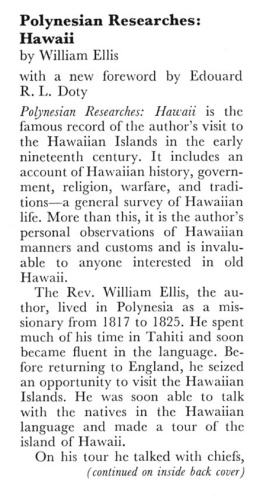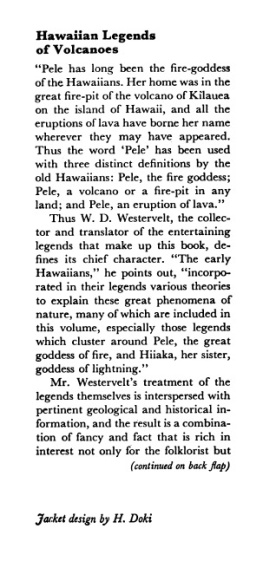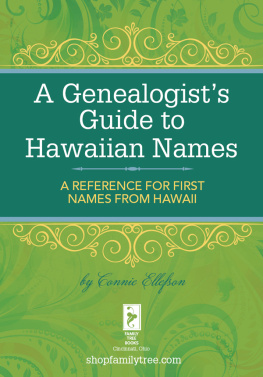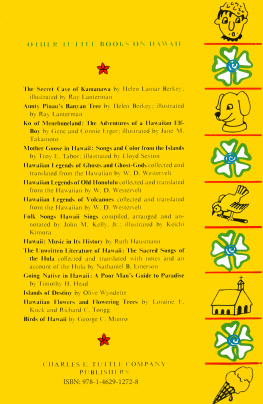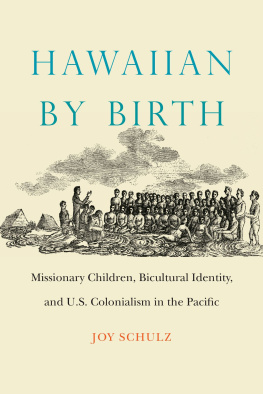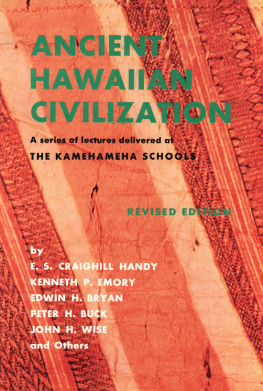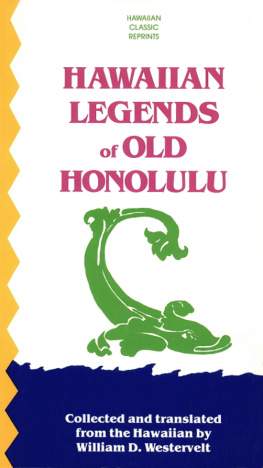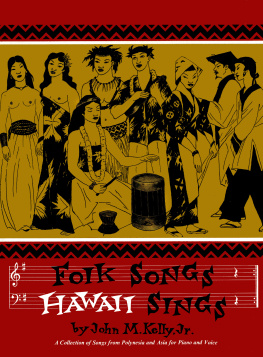APPENDIX.
REMARKS ON THE HAWAIIAN LANGUAGE.
IN the course of our tour around Hawaii, we met with a few specimens of what may perhaps be termed the first efforts of an uncivilized people towards the construction of a language of symbols. Along the southern coast, both on the east and west sides, we frequently saw a number of straight lines, semicircles, or concentric rings, with some rude imitations of the human figure, cut or carved in the compact rocks of lava. They did not appear to have been cut with an iron instrument, but with a stone hatchet, or a stone less frangible than the rock on which they were portrayed. On inquiry, we found that they had been made by former travellers, from a motive similar to that which induces a person to carve his initials on a stone or tree, or a traveller to record his name in an album, to inform his successors that he has been there. When there were a number of concentric circles with a dot or mark in the centre, the dot signified a man, and the number of rings denoted the number in the party who had circumambulated the island. When there was a ring, and a number of marks, it denoted the same; the number of marks shewing of how many the party consisted; and the ring, that they had travelled completely round the island; but when there was only a semi-circle, it denoted that they had returned after reaching the place where it was made. In some of the islands we have seen the outline of a fish portrayed in the same manner, to denote that one of that species or size had been taken near the spot: sometimes the dimensions of an exceedingly large fruit, &c. are marked in the same way.
With this slight exception, if such it can be called, the natives of the Sandwich and other islands had no signs for sounds or ideas, nor any pictorial representation of events. Theirs was entirely an oral language; and, whatever view we take of it, presents the most interesting phenomenon connected with the inhabitants of the Pacific. A grammatical analysis would exceed my present limits; a few brief remarks, however, will convey some idea of its peculiarities; and a copious grammar, prepared by my respected colleagues, the American Missionaries in those islands, and myself, may perhaps be published at no distant period.
The language of the Hawaiians is a dialect of what the Missionaries in the South Seas have called the Polynesian language, spoken in all the islands which lie to the cast of the Friendly Islands, including New Zealand and Chatham Island. The extent to which it prevails, the degree of perfection it has attained, the slight analogy between it and any one known language, the insulated situation, and the uncivilized character, of the people by whom it is spoken, prove that, notwithstanding the rude state of their society, they have bestowed no small attention to its cultivation, and lead to the inference, that it has been for many ages a distinct language; while the obscurity that veils its origin, as well as that of the people by whom it is used, prevents our forming any satisfactory conclusion as to the source whence it was derived.
The numerals are similar to those of the Malays; and it has many words in common with that language, yet the construction of the words and the rules of syntax appear different. In the specimen of languages spoken in Sumatra, given by Mr. Marsden in his history of that island, some words appear in each, common in the South Seas; and it is difficult to determine in which they preponderate. In looking over the Malayan grammar and dictionary by the same gentleman, many words appear similar in sound and signification; but there are a number of radical words common to all the Polynesian languages, as kanaka, man, ao, light, pouri, darkness, po, night, ra or la, sun, marama, moon maitai, good, ino, bad, ai, to eat, and moe to sleep, which, though very nearly the same in all the South Sea languages, appear to have no affinity with orang, trang, klam, malum, mataari, and shems, bulan, baik, baruk, makan, and tidor, words of the same meaning in Malayan: notwithstanding this, there is a striking resemblance in others, and a great part of the language was doubtless derived from the same source.
Since my return to England. I have had an opportunity of conversing with the Madagasse youth now in this country for the purposes of education, and from them, as well as a vocabulary which I have seen, I was surprised to learn, that in several points the aboriginal languages of Madagascar and the South Sea Islands are strikingly analogous, if not identical, though the islands are about 10,000 geographical miles distant from each other.
With the aboriginal languages of South America we have had no opportunity of comparing it; some of the words of that country, in their simplicity of construction and vowel terminations, as Peru, Quito, (pronounced kito,) Parana, Oronoko, &c. appear like Polynesian words.
In the Sandwich Islands, as well as the Tahitian language, there are a number of words that appear true Hebrew roots, and in the conjugation of the verbs there is a striking similarity; the causative active and the causative passive being formed by a prefix and suffix to the verb.
In many respects it is unique, and in some defective, but not in that degree which might be expected from the limited knowledge of the people. The simple construction of the words, the predominancy of vowels, and the uniform terminations, are its great peculiarities. The syllables are in general composed of two letters, and never more than three. There are no sibilants in the language, nor any double consonants. Every word and syllable terminates with a vowel; and the natives cannot pronounce two consonants without an intervening vowel; nor a word terminating with a consonant, without either dropping the final letter, or adding a vowel; hence they pronounce Britain, Beritani boat, boti; while there are many words, and even sentences, without a consonant, as e i ai oe ia a ae e ao a, literally, 'speak now to him by the side that he learn.' The frequent use of the k renders their speech more masculine than that of the Tahitians, in which the t predominates.
The sound of their language is peculiarly soft and harmonious; great attention is also paid to euphony, on account of which the article is often varied; the same is the case in the Tahitian, in which the word tavovvov signifies the rolling of thunder.
Each of the dialects appears adapted for poetry, and none more so than the Hawaiian, in which the I frequently occurs. Whether the smoothness of their language induced the natives to cultivate metrical composition, or their fondness for the latter has occasioned the multiplicity of vowels, and soft flowing arrangement of the sentences, which distinguish their language, it is difficult to conjecture. In native poetry, rhyming terminations are neglected, and the chief art appears to consist in the compilation of short metrical sentences, agreeing in accent and cadence at the conclusion of each, or at the end of a certain number of sentences. Rude as their native poetry is, they are passionately fond of it. When they first began to learn to read and spell, it was impossible for them to repeat a column of spelling, or recite a lesson, without chanting or singing it. They had one tune for the monosyllables, another for the dissyllables, &c. and we have heard three or four members of a family sitting for an hour together in an evening, and reciting their school lessons in perfect concord. Most of the traditions of remarkable events in their history are preserved in songs committed to memory, by persons attached to the king or chiefs; or strolling musicians, who travel through the islands, and recite them on occasions of public festivity. The late king had one of these

